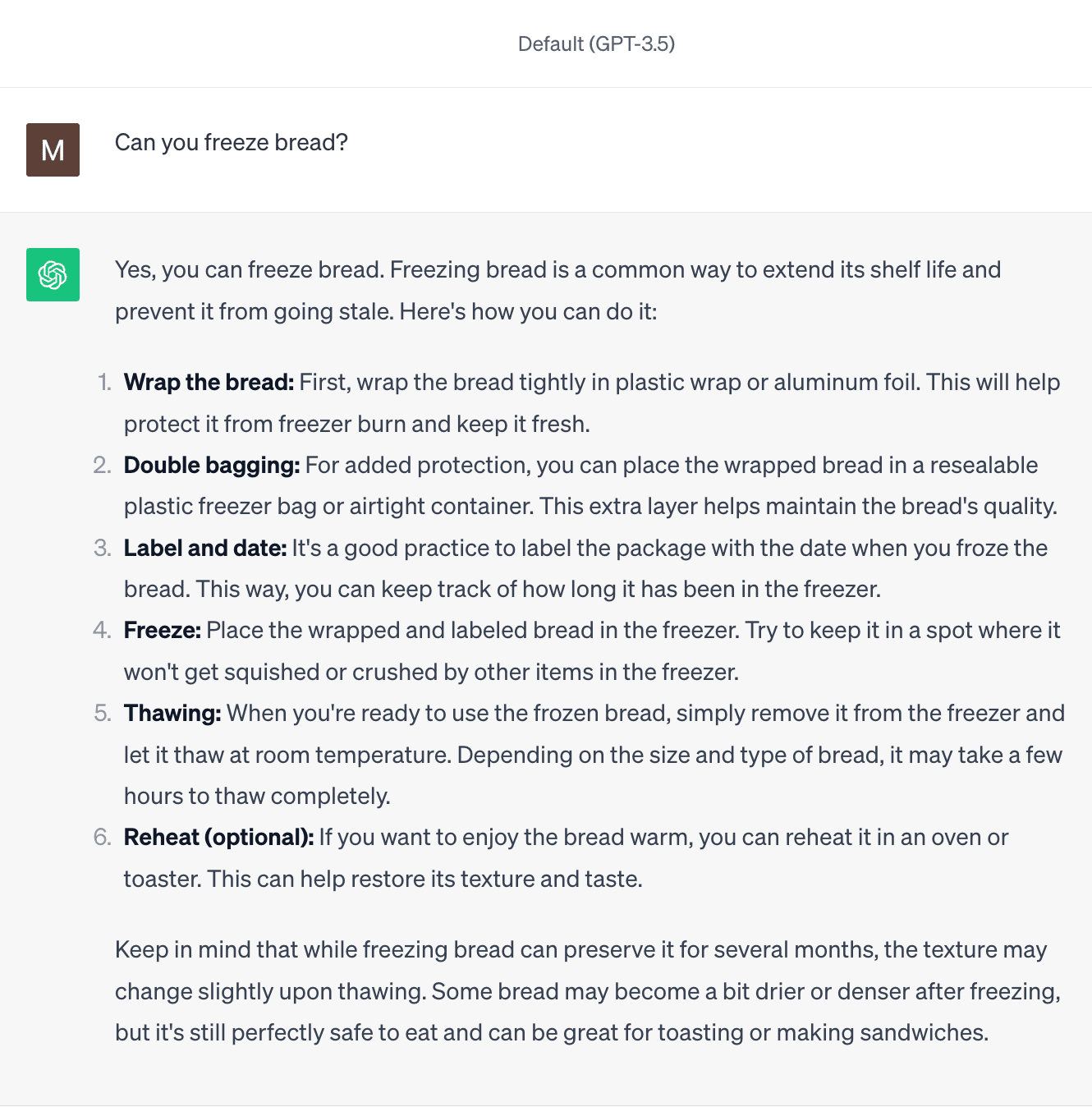Can you freeze bread?
Let's ask ChatGPT 😄
4 min readRandomness 😎
Sometimes taking a break from all the learnings is necessary and helpful and can be learning as well. 😜
A colleague of mine, called Iggy, a fine and beardy Finnish man, has once asked a random but very important question. The question was "Can you freeze bread?" 🤭
So what's the answer? 🤓

Yes, you can freeze bread. Freezing bread is a common way to extend its shelf life and prevent it from going stale. Here's how you can do it:
-
Wrap the bread: First, wrap the bread tightly in plastic wrap or aluminum foil. This will help protect it from freezer burn and keep it fresh.
-
Double bagging: For added protection, you can place the wrapped bread in a resealable plastic freezer bag or airtight container. This extra layer helps maintain the bread's quality.
-
Label and date: It's a good practice to label the package with the date when you froze the bread. This way, you can keep track of how long it has been in the freezer.
-
Freeze: Place the wrapped and labeled bread in the freezer. Try to keep it in a spot where it won't get squished or crushed by other items in the freezer.
-
Thawing: When you're ready to use the frozen bread, simply remove it from the freezer and let it thaw at room temperature. Depending on the size and type of bread, it may take a few hours to thaw completely.
-
Reheat (optional): If you want to enjoy the bread warm, you can reheat it in an oven or toaster. This can help restore its texture and taste.
Keep in mind that while freezing bread can preserve it for several months, the texture may change slightly upon thawing. Some bread may become a bit drier or denser after freezing, but it's still perfectly safe to eat and can be great for toasting or making sandwiches.
And can you unfreeze bread? 😳

Yes, you can unfreeze bread. To thaw frozen bread, follow these steps:
-
Remove from the Freezer: Take the frozen bread out of the freezer. It should be in the original wrapping or an airtight container.
-
Unwrap (if necessary): If the bread is wrapped in plastic wrap or aluminum foil, you can remove the outer wrapping to help with the thawing process.
-
Thaw at Room Temperature: Place the unwrapped bread on the kitchen counter or another room-temperature surface. Leave it to thaw at room temperature. Depending on the size and type of bread, it may take a few hours to thaw completely. You can speed up the process by breaking the bread into smaller pieces or slices.
-
Reheat (optional): If you prefer your bread warm, you can reheat it in an oven or toaster. This can help restore its texture and taste, especially if it has become slightly dry after freezing.
Do not thaw bread in a microwave unless you plan to consume it immediately, as microwaving can make it soggy or dry it out. Thawing at room temperature is generally the best method for preserving the bread's quality.
Once the bread is thawed, it is safe to eat, and you can use it as you normally would for sandwiches, toasting, or any other recipes that call for bread.
What does "thaw" mean? 🤨
To "thaw" means to allow something that is frozen to return to its natural or desired temperature, typically by letting it warm up gradually. Thawing is the process of reversing the freezing of an object or substance. When it comes to frozen food, including bread, thawing involves bringing it back to its normal, non-frozen state.
For example, if you have a piece of frozen bread, thawing it means allowing it to warm up and become soft again so that it's ready to be eaten or used in recipes. This is typically done by leaving the frozen item at room temperature until it reaches the desired state of being unfrozen and easy to work with. Thawing can also be achieved through methods like using a microwave on a defrost setting or immersing the item in cold water. The specific method you use for thawing may depend on the item and your preferences.
Recap please 🤯
It seems that you can freeze and unfreeze bread, but should you? A question asked by another colleague, called FBI, who investigates a variety of criminal activities 👻. This will be answered soon in another post! See you soon 😎